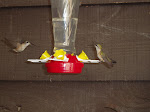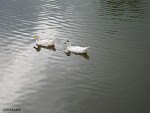 These photos are of a male Northern Flicker that lived at our property in central British Columbia, Canada for approximately 2 years.
These photos are of a male Northern Flicker that lived at our property in central British Columbia, Canada for approximately 2 years.  The unfortunate bird had a horrible beak deformity that only got worse over time.
The unfortunate bird had a horrible beak deformity that only got worse over time. We did what we could to make it easier for him to eat & his ingenuity at doing so was amazing. Here he is pushing his beak under his wing in an effort to get the corn kernel closer to his mouth.
We did what we could to make it easier for him to eat & his ingenuity at doing so was amazing. Here he is pushing his beak under his wing in an effort to get the corn kernel closer to his mouth. He was always pretty perky & ate lots. He never made a sound & other birds gave him a wide berth.
He was always pretty perky & ate lots. He never made a sound & other birds gave him a wide berth. When using this wire cage suet feeder he would saw his beak back & forth then lick off the suet collected on his beak.
When using this wire cage suet feeder he would saw his beak back & forth then lick off the suet collected on his beak. In the end he finally did succumb to his huge beak, not because he couldn't eat but by becoming lodged inside of a tree cavity. I doubt we could have saved him even if we had known his predicament.
In the end he finally did succumb to his huge beak, not because he couldn't eat but by becoming lodged inside of a tree cavity. I doubt we could have saved him even if we had known his predicament.
Had the wind not blown over a Poplar in our front yard we would never have learned his fate. The Poplar is the tall, white tree with no leaves on the right.

While bucking up the fallen tree, a cut any higher & his remains would have been destroyed. Any lower & we would never have found him.


 This is what was left of him after being stuck in the tree cavity for so long. Talk about long in the tooth!
This is what was left of him after being stuck in the tree cavity for so long. Talk about long in the tooth!After he'd been here a few months I joined an "e" bird group & posted information about the flicker.
It didn't take long for the birding community to want to know more about him. I was eventually asked if I would be interested in reporting on my observations & of course I jumped at the chance.
"My" bird & I became momentarily famous & I received correspondence from all over the world.
At the bottom of this blog installment are the 2 articles that were written about him, by me. Pretty cool! They even used my drawings & photos.
The articles were featured in a newly created journal called "Wildlife Afield".
This malady is becoming more & more prevelant & so far the cause is unknown.
It's pretty scary though to think we are mostly likely the reason for these deformities.
We have had one more bird with a deformed beak, a year or so after the flicker.
It was a female Black-chinned Hummingbird, it was the first time in 17 years at this location that I had seen one. The tips of her beak were spread apart at the ends much like a cocktail wiener fork. She had no problem fiting her beak in the feeder port holes though. We saw her most of that summer & have never seen her or another Black-chinned again.
Below are the links to my published articles.Enjoy!
This first link is about when he was alive.
This link is about finding his remains several months later. What a fluke!
Here is the link to "Wildlife Afield"
They collect data & report on all wildlife happeningsin British Columbia.
This is a very interesting website. It is the Alaska Science Center.
They are studying beak deformities in birds & are centered in Alaska where the majority of deformities occur. They have tons of photos & "my" flicker is also on there. They were one of the first to contact me after hearing about the flicker we had.

.png)






1 comment:
Tammy Harrison said...
This was a very interesting story about the flicker you found. It's so sad, but we all know that birds with this type of deformity don't last long. You are right in saying that he was "long in the tooth". The one that came to my yard yesterday (April 2, 2009) I had seen somewhere else in Ashcroft. I hope to see him again, hopefully earlier in the day and sunny. That makes for a better photo. Thankfully the camera was handy and I photographed him and video taped him (hmm video tape with a digital camera?). So I wil always have it. Great blog. I will return to it and read some more.
Tammy Harrison
Ashcroft, BC
April 3, 2009 1:10 PM
Post a Comment